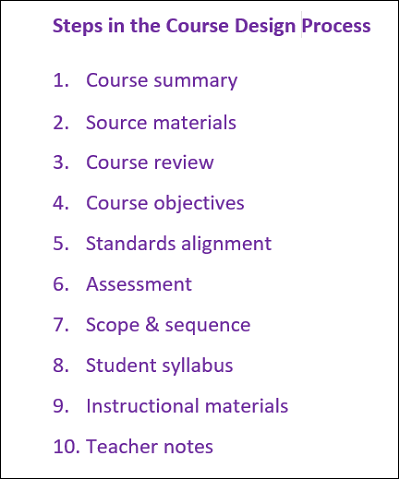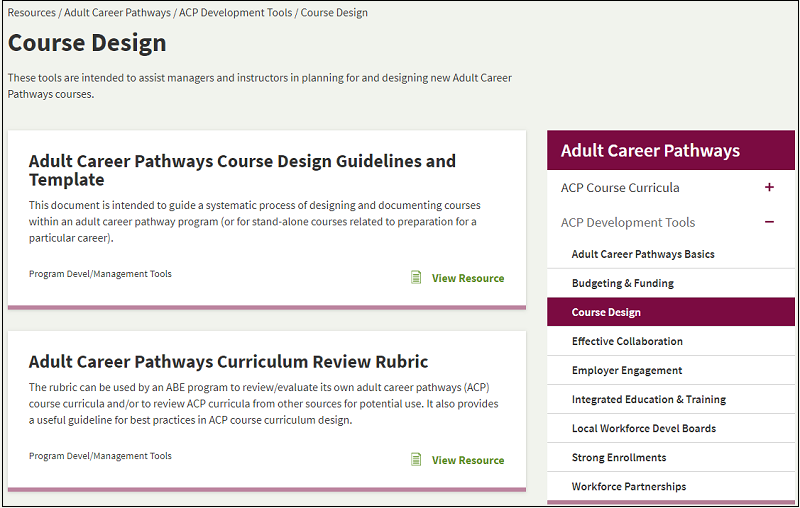- MN ABE Connect
- Archive
- Career Pathways Course Design: Tools and Tips
 June 4, 2019
June 4, 2019
Career Pathways Course Design: Tools and Tips
Liz Andress, Adult Career Pathways ConsultantATLAS has excellent resources available to guide a step-by-step process of course design. You’ll find a set of Guidelines and an easy-to-use accompanying Template that ensures clear documentation of all elements of a course from the outset. Are you working on your Regional Transitions Plan? These tools could be especially useful! Have you been tasked with creating or strengthening a career pathway at your site? You’ll want to dig into these resources!
All materials are available in the ATLAS Adult Career Pathways online resource library. They have been used in conjunction with a professional development training cohort and are now available for independent use by ABE practitioners. (The quotes in this article are from past cohort participants.)
The need
As we develop career pathway programs with collaborating partners in our localities, ABE programs need to be able to design and deliver quality courses for credential exam prep, “bridging” to postsecondary training or “on-ramping” in early exploration of a career sector. The course design often needs to be completed in a short period of time. Without a systematic approach, this important work can be haphazard, disorganized and difficult to thoroughly document or replicate. A well-designed course, on the other hand, leads to a much better learning experience for students! Plus, a well-documented course can easily be revised and offered again at your site or elsewhere. In our ABE field, good work should be shared!
Guidelines and template provide clear process
The Guidelines instruct on how to complete each piece of a ten-step process:
- Course summary
- Source materials
- Course review
- Course objectives
- Standards alignment
- Assessment
- Scope & sequence
- Student syllabus
- Instructional materials
- Teacher notes
The steps can then be completed in an easy-to-use template to ensure that each step is clear and thorough. The result is a comprehensive overview of a course that is well-organized, cohesive and learner-centered.
The first three steps help the course designer to get clear on “what I know and what I need”. The Course Summary outlines key information about the course that the program and instructor should be clear about before proceeding further with course design. (It also serves as a “cover page” when sharing the curriculum with other programs.) Documenting Source Materials ensures that the designer has found all relevant existing materials in the ATLAS online resource library, within their own program and from other sources; and requires that they identify materials still needed, with a plan and timeline for obtaining them. The Course Review lays out criteria for a quality course design and asks the course designer to evaluate what needs to be done to meet those criteria.
Course design – start with clear objectives
A Course Design Cycle proposed by D. Fowler, et al., “starts with the end in mind asking the questions: What do we want students to know, be able to do, and what will they value when they complete the course?” This is the first stage of backward design (Wiggins & McTighe, 2005; as quoted in Fowler et. al. 2011), followed by determining how learning will be assessed, and only then creating learning activities that will help students attain the course learning objectives. This ensures that our “instruction planning [is] targeted and purposeful.”
“Writing the course objectives for my Introduction to Child Development course was the hardest and most important part of the process for me. I now have a cohesive set of objectives that cover occupational knowledge and skills plus literacy and numeracy, transitions and digital skills.” – Laura Temali, St. Paul ABE
The short article Articulate Your Learning Objectives along with a useful list of action verbs based on Bloom’s taxonomy can be helpful in defining the level of complexity of our goals for students’ achievement. “For example, do we want students to be able to recall information, apply concepts, or create new knowledge?” (D. Fowler, et al.)
Standards alignment is closely tied to the learning objectives. Then Assessment outlines how students will be evaluated on their attainment of course objectives.
Quality course design for better instruction and easier sharing
 A scope and sequence outlines what will be covered in the course and in what order. This is where everything comes together.
A scope and sequence outlines what will be covered in the course and in what order. This is where everything comes together.
“Writing a thorough Scope and Sequence for our Commercial Driver’s License Exam Prep course was a huge accomplishment. It clarified for me the various elements and order of the course and allowed me to hone parts of the course I was struggling with.” – Liz Harner, SouthWest Metro ABE
A student syllabus can then be written to communicate course objectives, assessment plans, scope and sequence in student-friendly language.
“I especially liked creating a syllabus for the Nursing Assistant Prep course – writing something to communicate with my students directly and setting the tone for my class. I am using some of the classroom expectation language in syllabi for new courses I’m now teaching.” – Kristin Klas, Minneapolis Adult Education
Planning instructional materials and providing brief teacher notes rounds out the process. And then it’s time to teach! The feedback from learners is the most important, of course, and guides ongoing reflection and course revision.
The value of using these tools for quality design of career pathway courses is clear.
“Pulling all the pieces together in a systematic way allows me to prepare well for the students’ learning experience, which of course is the whole point. Also, the course design document becomes a curriculum that can be shared with other ABE professionals, who in turn should be able to pick it up and in minimal time prepare and teach the course in another program.” – Bill Crozier, Southeast ABE, Winona
Additional materials – and more coming soon!
The ATLAS Course Design webpage includes several short articles that inform the various course design steps. In July 2019, on the NEW ATLAS website, watch for several additions, including a set of course design examples that you will find especially helpful.
Want support in your course design process? Watch for a list of course design “coaches” who can contract directly with your program to help support teachers / curriculum writers in their work.
Contact Liz Andress, ATLAS Adult Career Pathways Consultant, at [email protected] with any questions or needs related to career pathway course design.
Reference:
Fowler, D., Sandoval, C., Layne, J. & Macik, M. (2011). Course Design Cycle. Retrieved from www.cte.tamu.edu.
Newsletter Signup
Get MN ABE Connect—the official source for ABE events, activities, and resources!
Sign UpArticle Categories
- ABE Foundations/Staff Onboarding
- ACES/Transitions
- Adult Career Pathways
- Assessment
- CCR Standards
- Citizenship
- COVID-19
- Cultural Competency
- Digital Literacy/Northstar
- Disabilities
- Distance Learning/Education
- ELA
- Equity/Inclusion
- ESL
- HSE/Adult Diploma
- Listening
- Math/Numeracy
- Mental Health
- Minnesota ABE
- One-Room Schoolhouse/Multilevel
- Professional Development
- Program Management
- Reading
- Remote Instruction
- Science
- Social Studies
- Speaking/Conversation
- Support Services
- Teaching Strategies
- Technology
- Uncategorized
- Volunteers/Tutors
- Writing
